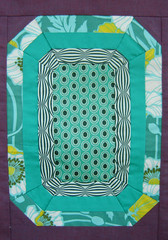One of the decisions that will need to be made when creating a quilt is the decision on how you are going to finish the raw edges. This article will discuss the three most common methods of binding quilts.

The most popular way to finish quilt edges is a method called binding. To bind an edge, you take a long strip of fabric (usually 2 ½ inches in width that is folded down the center lengthwise) and encase those raw edges of your quilt using this long strip. You can buy pre-made binding or you can create binding out of your choice of fabric. There are two different cuts that can be made in this style of binding. One cut is called bias binding and the other cut is called straight-edge binding.
Quilt
Bias binding is binding that is cut diagonally across the weave of the fabric. When you look closely at the binding strip, the threads are weaved in an X pattern. Bias binding is easier to stitch to your quilt as it is easier to sew around curves. It has some stretch to it and so it tends to pucker less than binding that has been cut on the grain. Bias binding is done after the quilt sandwich has been quilted together whether the quilting had been done by hand or by machine. Bias binding is the most popular form of quilt binding.
Straight edge binding is binding cut on the grain. When you look closely at the weave of the binding strip, you will see that the threads are weaved in a vertical and horizontal pattern. Straight edge binding is good to use on smaller projects where there are only straight edges and there are no little adjustments that need to be made. Binding whether cut on the bias or on the straight edge is sewn to the raw edges after the quilt sandwich has been quilted.
The second method of binding is called self-binding or fold-over binding. This method of quilt binding uses the extra fabric from the backing of your quilt. You fold over that extra fabric to the front side of your quilt and sew that fabric in place. Fold-over binding does not have the flexibility of a bias binding so it should only be used for small quilt projects. If self-binding is used on large quilt projects, the long edges of your quilt may end up not appearing smooth and may actually appear rippled. Self-binding is also done after the quilt sandwich has been quilted.
The third method to finish your quilt is a method called pillow-style finishing. After piecing your top fabric, you will sew the quilt layers together in the following order: the batting, the top pieced fabric and the backing fabric. Make sure that the top fabric and the backing fabric have the right sides together facing each other. Sew around all the raw edges of the quilt sandwich leaving an opening on one side large enough to turn the whole quilt inside out. The points of the corners are then trimmed. Be careful not to cut the stitching when trimming the corners. When the sewing is finished and you finish turning the quilt inside out, the right sides of the top fabric and the backing fabric should be facing out. The batting should be nestled inside. The opening is then hand sewed closed. After the raw edges of the quilt are finished, the quilting of the sandwich begins.
Now you know the different methods of finishing the edge of a quilt. The decision is now up to you as to which method will be best suited to your own particular quilt. Whatever you decide, I am sure that the results will be spectacular.
Quilt Binding - Finishing the Raw Edges
ไม่มีความคิดเห็น:
แสดงความคิดเห็น